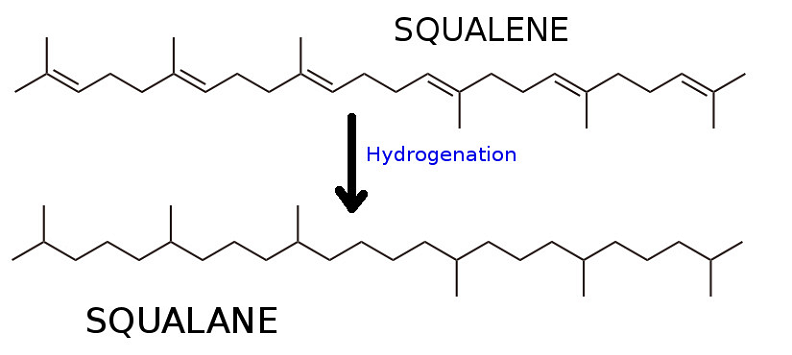
Here we explore two remarkable, yet often misunderstood ingredients in the world of skincare: Squalane and Squalene. In a market flooded with a plethora of skincare products, it’s crucial to understand what goes into these products and how they can benefit your skin. Squalane and Squalene, though similar in name and origin, have distinct characteristics that set them apart. Originating from natural sources, these ingredients have made a significant impact on skincare routines around the globe.
Contents
Introduction to Squalane and Squalene
In a realm where the pursuit of perfect skin never ceases, understanding the nuances of what we apply to our skin is more than a luxury — it’s a necessity.
Brief Overview of Skincare Importance
Skincare is not just about beauty; it’s a crucial aspect of our overall health and well-being. Our skin, being the largest organ of our body, serves as a protective barrier against environmental aggressors. It reflects our internal health and is often the first to signal when something is amiss within. In recent years, there has been a burgeoning awareness about the importance of skincare, leading to an influx of products and ingredients, each promising exceptional benefits. Among these, squalane and squalene have emerged as prominent players.
Introduction to Squalane and Squalene
Squalane and squalene, though they sound remarkably similar, have distinct characteristics and roles in skincare. Both originate from natural sources and have been lauded for their moisturizing and protective properties. But what exactly are they? Are they interchangeable? How do they impact our skin? These are some of the questions we’ll be addressing, providing you with a clear understanding of each.
Understanding Squalene
Before going into the specifics of squalene, it’s essential to establish a foundational understanding of this intriguing skincare ingredient. Squalene is not just another component in the long list of skincare additives; it holds a special place due to its unique properties and origins.
Definition and Origin of Squalene
Squalene is a natural compound that is classified as a triterpene, a type of hydrocarbon. In simpler terms, it’s an organic compound that plays a vital role in synthesizing various natural substances, including steroids. Squalene is produced naturally in the human body, specifically in the sebaceous glands, where it contributes to the skin’s natural lipid barrier. This barrier is critical for keeping the skin hydrated and protecting against environmental stressors.
The origin of squalene, however, extends beyond the human body. It is also found in various natural sources, such as olives, rice bran, and amaranth seeds. Historically, squalene was predominantly derived from shark liver oil, a practice that raised significant environmental and ethical concerns. Today, the cosmetic industry primarily relies on plant-based sources, aligning with a more sustainable and ethical approach [1].
Natural Sources of Squalene
The shift to plant-based sources for squalene has opened up a variety of options. Some of the most common sources include olive oil, amaranth seed, wheat germ, and rice bran. Each source offers a slightly different composition of squalene, which can influence its effectiveness and suitability for various skin types. The use of these natural sources not only ensures a sustainable supply of squalene but also aligns with the growing demand for natural and organic skincare products.
Role of Squalene in Skincare
In skincare, squalene plays a multifaceted role. Its most notable attribute is its emollient property, which helps in softening and smoothing the skin. This is particularly beneficial for individuals with dry or rough skin textures. Additionally, squalene is an excellent natural moisturizer, helping to maintain the skin’s hydration levels by preventing moisture loss. Its molecular structure closely resembles that of the skin’s own lipids, making it easily absorbable and highly effective in reinforcing the skin’s natural barrier.
Benefits of Squalene for Skin Health
The benefits of squalene extend beyond simple hydration. It’s known for its antioxidant properties, which help in fighting free radicals and protecting the skin from environmental damage, such as pollution and UV radiation. This can result in reduced signs of aging and a more youthful, radiant complexion. Furthermore, squalene’s compatibility with all skin types, including sensitive and acne-prone skin, makes it a versatile ingredient in various skincare formulations [2].

Exploring Squalane
After gaining an understanding of squalene, it’s crucial to explore its counterpart, squalane. While these two compounds are closely related, they have distinct characteristics that set them apart in the realm of skincare.
Definition and Derivation of Squalane from Squalene
Squalane is a derivative of squalene. The key difference lies in their stability: squalene is unsaturated and can be prone to oxidation, whereas squalane is a saturated form that is more stable and less prone to oxidization. This stability makes squalane more suitable for use in skincare products. The conversion process from squalene to squalane involves hydrogenation, where the unsaturated squalene is transformed into a fully saturated and stable compound.
Comparison of Squalane with Squalene
While both squalane and squalene are excellent moisturizers, their differences impact their use in skincare formulations. Squalane’s stability means it has a longer shelf-life and doesn’t easily turn rancid, unlike squalene. This stability also allows squalane to maintain its efficacy in skincare products over time, ensuring the benefits are delivered consistently with each use [3].
Benefits of Squalane in Skincare
Squalane inherits many of the skin-friendly properties of squalene, such as its emollient and moisturizing capabilities. However, its stable nature means it’s even more effective in protecting the skin’s lipid barrier, preventing moisture loss, and providing a soft, smooth texture to the skin. Squalane is also non-comedogenic, meaning it won’t clog pores, making it suitable for all skin types, including oily and acne-prone skin. Its gentle nature also makes it ideal for sensitive skin types.
Squalane in Cosmetic Products
Due to its stability and skin-friendly properties, squalane is a popular ingredient in a variety of cosmetic products. It’s found in moisturizers, serums, facial oils, and even in makeup products like foundations and lipsticks. Squalane helps in improving product spreadability and absorption, enhancing the overall user experience. Its versatility and efficacy have made it a staple ingredient in the formulation of high-quality skincare and cosmetic products.

Squalane vs. Squalene: A Detailed Comparison
Having explored both squalane and squalene individually, it’s essential to draw a detailed comparison between the two. This comparison will highlight their distinct characteristics and help you understand why and how each is used in skincare products.
Chemical Composition and Stability
The primary difference between squalane and squalene lies in their chemical composition and stability. Squalene is an unsaturated oil, which makes it less stable and more prone to oxidation when exposed to air and light. This susceptibility to oxidation can lead to a shorter shelf life and potential skin irritation if the product turns rancid. On the other hand, squalane is a saturated oil, which means it’s much more stable, doesn’t oxidize easily, and has a longer shelf life. This stability makes squalane a more reliable and consistent ingredient in skincare formulations [4].
Absorption and Efficacy in Skincare
Both squalane and squalene are known for their excellent moisturizing properties, but their absorption rates and overall efficacy in skincare differ slightly. Squalene, with its lighter molecular structure, is absorbed quickly by the skin, providing immediate hydration. However, its instability can affect its long-term effectiveness.
Squalane, while also providing significant hydration, has a slightly heavier consistency. It forms a protective barrier on the skin, locking in moisture for a more extended period. This makes squalane particularly beneficial for long-lasting hydration and protection against environmental factors.
Suitability for Different Skin Types
When it comes to suitability for different skin types, both squalane and squalene are generally well-tolerated by most skin types. However, their specific characteristics make them more suitable for certain conditions. Squalene’s lighter texture makes it ideal for normal to oily skin types, as it moisturizes without leaving a greasy residue.
In contrast, squalane’s heavier and more protective nature makes it especially beneficial for dry, mature, or sensitive skin types, providing long-lasting hydration and barrier protection.
Environmental Impact and Ethical Considerations
The environmental and ethical considerations surrounding squalane and squalene are also significant factors in their comparison. Traditionally, squalene was sourced from shark liver oil, raising serious environmental and ethical concerns. The shift to plant-based sources for both squalene and squalane aligns with sustainable and ethical practices.
However, it’s crucial for consumers to be aware of the source of these ingredients in their skincare products. Plant-derived squalane and squalene are considered more environmentally friendly and ethically sound choices.
How to Choose Between Squalane and Squalene
With a clear understanding of the differences between squalane and squalene, the next step is to determine which one is more suitable for your skincare needs. This decision is not just about personal preference; it involves considering various factors like skin type, allergies, and specific skin concerns.
Factors to Consider (Skin Type, Allergies, Climate)
Skin Type
Your skin type is perhaps the most crucial factor to consider. For oily or acne-prone skin, squalene’s lighter texture may be more beneficial as it moisturizes without adding excess oil. For dry or mature skin, squalane’s heavier consistency and barrier-forming properties can provide more intensive hydration and protection [5].
Allergies
If you have sensitive skin or are prone to allergies, you’ll need to be cautious. While both squalane and squalene are generally well-tolerated, it’s always wise to perform a patch test before fully integrating a new product into your skincare routine.
Climate
The climate you live in can also influence your choice. In a humid environment, a lighter moisturizer like squalene might be preferable, whereas in a dry climate, the more substantial hydration offered by squalane could be more beneficial.
Recommendations for Specific Skincare Needs
Anti-Aging
For anti-aging concerns, squalane might be the better choice due to its ability to deeply moisturize and protect the skin barrier, thereby reducing the appearance of fine lines and wrinkles.
Sensitive Skin
Those with sensitive skin may find squalane to be more suitable, as its stability and gentle nature are less likely to cause irritation.
Acne-Prone Skin
For acne-prone skin, squalene’s lighter texture is preferable as it hydrates without clogging pores or adding excess oil.
Label Reading and Identifying Quality Products
Finally, when selecting products containing squalane or squalene, it’s essential to read labels carefully. Look for products where these ingredients are listed towards the top of the ingredient list, indicating a higher concentration. Additionally, be mindful of the source – opt for plant-derived squalane or squalene to ensure ethical and sustainable sourcing.
Choosing between squalane and squalene doesn’t have to be complicated. By considering your skin type, potential allergies, the climate you live in, and your specific skincare needs, you can make an informed decision that best suits your skin. Remember, skincare is personal, and what works for one person may not work for another. It’s all about finding the right balance for your unique skin.
References
[1] Squalane vs Squalene- What’s the Difference?
[2] Biological importance and applications of squalene and squalane
[3] Squalane vs Squalene: What Is the Difference?
[4] Squalane Vs. Squalene For Skin: The Subtle Yet Profound Difference
[5] The difference between Squalane and Squalene
